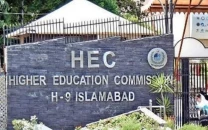Sexual harassment: A nightmare for higher education
Cases of sexual harassment on campuses involving teachers and students need to be looked at minutely

University of Karachi. PHOTO: MOHAMAMD NOMAN/EXPRESS
Institutes of higher education are bound to offer an environment of freedom that can equally be exercised by the teacher and the student. Any behaviour obstructing this freedom results in jeopardising the purpose of higher education and harms the sanctity of the whole idea of coming together for imparting and creating knowledge.
Students get together to break silence on sexual harassment at campuses
Cases of sexual harassment on campuses involving teachers and students are of highly sensitive nature and need to be looked at minutely. Sometimes, purportedly the motive behind such accusations is political and therefore they fizzle out. At others, cases of on campus sexual harassment by persons in authority have not only been inquired into and proven correct but later in practice found to be unresolved and the offender unpunished.
This compels the intelligentsia in and out of education sector to think, whether there are mechanisms to deal with genuine cases of sexual harassment on campuses. Whether the offenders are brought to justice and the victim is given confidence to carry on as it was.
The unfortunate ignorance
A common misconception is that the Protection Against Harassment of Women at the Workplace Act 2010 is only for workplaces such as factories and offices. This is not correct as it does cover the educational institutions as well. However, the point is whether it covers the students or not. For all practical purposes it does as it mentions, “accused” means an employee or employer of an organisation against whom complaint has been made under this Act. “Complainant” means a woman or man who has made a complaint to the Ombudsman or to the Inquiry Committee on being aggrieved by an act of harassment. It is clear a complainant can be anyone and he/she does not need to be employed within the organisation.
At higher education institutions such complaints can be lodged with an inquiry committee, the establishment of which is direct responsibility of the universities. This has explicitly been outlined in policy guidelines against sexual harassment issued by the Higher Education Commission.
So seemingly the mechanisms are in place. But are they being used? Not really. The problem lies with the stages of execution and the institutional will to carry it out. Once reported, mostly the first reaction of the institution is to hush it up. If the complainant is persistent, it is followed at a very slow pace. Most of the cases remain unresolved, leaving the victim embarrassed and exposed to repetitive attempts of harassment.
The point of concern is that the main stakeholders, most of the time, also seem disinterested. The knowledge of existence of such mechanisms or a will to actively seek information is practically non-existent and most of the teachers and students are ignorant of the existence of such a policy. Also they seem to be indifferent on the pretext that even if something exists, the conviction of its coming into force does not.
Need of the hour
Universities will have to realise that to restore honour and sanctity attached to them, they will have to make the mechanisms transparent and known to all. All universities must include the policy guidelines and rules governing sexual harassment in their orientation packs for students and the same needs to be done on their websites.
Sexual harassment a bitter pill to swallow for KU
They must establish effective harassment complaint cells and appoint qualified people as harassment monitoring officers with proper record keeping facilities. Once a complaint is received it must be given a prompt and fair hearing to establish responsibilities. This must be followed by immediate appointment of inquiry committee with impartial people. The committee must not take long to summon both the parties as the longer it takes the greater the chances of victim being pressurised into silence.
The universities must capitalise on availability of their highly qualified workforce and engage them to converge on indigenous solutions. The challenge, however, will remain a strong will to bring justice to everyone. Based on previous cases, institutional failure of universities to respond to cases of sexual harassment in a sensitised way has been established. They now need strong testimonials to prove their point otherwise.
Samina Qureshi is an assistant professor at the department of Mass Communication in University of Karachi and a freelance development practitioner.



















COMMENTS
Comments are moderated and generally will be posted if they are on-topic and not abusive.
For more information, please see our Comments FAQ